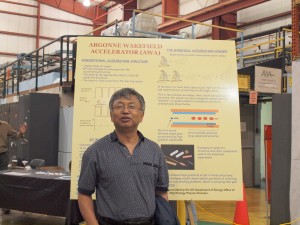
New GDE Positron Technical Area Group Leader Wei Gai stands in front of a poster on wakefield acceleration, one of his research focuses. Gai also heads the Argonne Wakefield Acceleration Group. Image: Jennifer Seivwright
Scientists at the ILC who deal in matters positively charged have a new go-to guy: Wei Gai. This month, Gai assumes the role of the ILC’s Positron Technical Area Group Leader (Positron TAGL). He takes over the position from Jim Clarke at the Science & Technology Facilities Council/Daresbury Laboratory in the UK, who has given up the role because of the UK’s changing programme priorities.
Gai enters the role at a crucial time in ILC development. He will oversee the contribution of positron-related R&D in the months leading up to the 2012 publication of the Technical Design Report, a milestone document for the ILC. During that time, he will work with Global Design Effort (GDE) project managers and research scientists from approximately ten laboratories to identify critical issues in positron source development. He will also help decide how best to marshal human and financial resources in the ILC’s positron arena.
“One of the main reasons I accepted this position is that I want to help realise all the work we have put into the ILC positron source,” said Gai.
Certain aspects of the positron source are at the top of his agenda as the new technical area group leader. He aims to resolve open issues related to the rotating positron target, a metallic spinning wheel that takes on high-intensity photons, converting them to positrons. This involves a collection device, a magnet that captures positron beams with large divergent angles and energy spreads. Scientists at the Cockcroft Institute in the UK and at Lawrence Livermore National Laboratory in the US are developing the target and associated capturing devices.
Gai is also focusing on further development of a shorter-period undulator, which generates the photons. That research is also being conducted at the UK labs and possibly at his home lab, Argonne National Laboratory in the US, in the near future.
“I’m looking forward to a successful, concrete demonstration of these key technologies,” Gai said.
As a longtime ILC collaborator, Gai has both big-picture and thumbnail views of the ILC positron system. His own fluency in particle beam physics originates from his work at Argonne, where he researches wakefield acceleration and high-current electron beam physics. That research nicely dovetailed with the work that needed to be completed for ILC’s positron source development, and he joined the collaboration in 2005.
“Positron physics is very similar to electron beam physics,” Gai said. “You just switch the sign in the simulation code. It’s not that complicated.”
Of course, it isn’t that simple, either, and GDE project managers recognise Gai’s skill in optimising positron source components.
“We hope Wei will be able to mobilise Argonne expertise to help with key positron target technical issues,” said Project Manager Marc Ross.
Mobilising expertise will be nothing new for Gai, who has served for 15 years as a group leader at Argonne, where he will continue to head the Wakefield Accelerator Group.
Former Positron TAGL Jim Clarke successfully oversaw the construction and testing of a rotating positron target prototype at Daresbury. He also led the effort for constructing and testing an undulator at Rutherford.
“I’m looking forward to learning from John Sheppard of SLAC and Jim Clarke, whose wisdom in these matters can only help me in fulfilling the ILC’s mission,” said Gai.
Stay tuned to NewsLine to learn about the rotating positron target, undulators, and Clarke’s contributions to these projects.

Recent Comments